Meet the Planets
Who's Who & What's What in the Illustrations of Meet the Planets
There is always more going on in an illustration than you might realize. Every drawing tells a story, sometimes more than one, beyond the actual words written on the page. Before pencil ever touches paper there is research - lots of it. No matter how simple the narrative, the artist needs to look up every bit of information they can on the subject so that the final piece of art is not only engaging and entertaining but also accurate. Ultimately that information finds its way into the artwork.
In the case of "Meet the Planets" I had more information than I knew what to do with. While I fully expected my research to lead me to Science and Astronomy, I did not expect to touch every other art and discipline imaginable. Astrology, Biology, Chemistry, Physics, Math, Philosophy, Literature, History, Mythology, Fine Arts, Pop Culture, Science Fiction, and Music all had something to share in defining and illuminating the universe and I eventually found a home for everything, or a good portion of it, in the illustrations for this book. Some of these elements and figures from history and science are described or explained by the story, but for those that are not the following pages are provided.
You have met the planets, now meet all the things going on behind the planets.
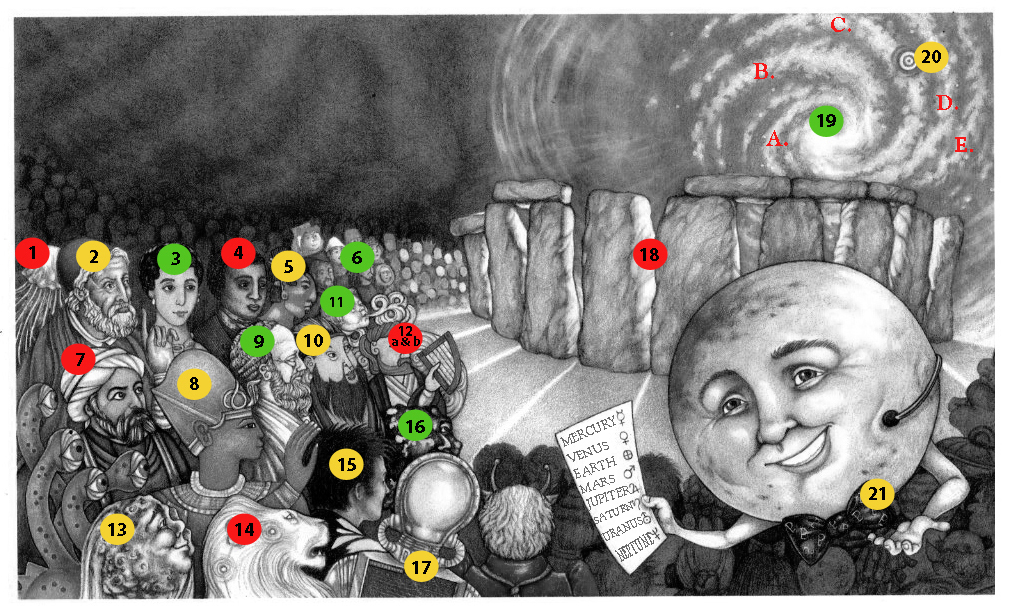
Introduction
Since this was supposed to be a competition I immediately thought of the awards shows you see on TV and decided we needed a stage set for the first illustration. What could be better than Stonehenge. Originally I was simply going to have the audience in silhouette but after I started finding all these amazing people from history and science I decided their faces should be seen.
- JELLYFISH: 1st primitive animals appear on Earth 600 million years ago.
- PTOLEMY: (100 - 178) Alexandrian Greek philosopher & astronomer. Thought Earth was the center of the universe.
- HYPATIA: (415) Alexandria. Female astronomer, astrologer, mathematician
- BENJAMIN BANNEKER: (1731 - 1806) 1st African American astronomer, mathematician & scientist. Calculated the astronomical tables & predicted an eclipse (which was not easy to do at the time).
- MAYANS: (1000) Mayans build an observatory
- CROWD INSPIRED BY 1490 ENGRAVING OF THE PTOLEMIC UNIVERSE
- ABD AL-RAHMAN AL-SUFI: (964) Persian astronomer. Compiles "The Book of Fixed Stars." According to some historians, Persian astronomers invented the astrolabe in 400
- RAMESES THE GREAT: (1,200 BC) Earliest known almanac created during reign of Egyptian pharaoh
- THALES : (585 BC) Greek astronomer, predicts solar eclipse
- CHINESE ASTRONOMERS: (2,300 BC) build observatories & make earliest known observation of a comet in 2,296 BC
- WIND CHERUB: popular way of depicting wind in Western Art
- a: NEOLITHIC STONE & BURIAL CHAMBER: (Newgrange, Ireland 3,200 BC) Aligned so that on the day of the Winter Solstice sunlight illuminates the rear wall of the chamber, conceivably making it the 1st solar observatory.
b: TALIESON: ancient Celtic poet (in style of Medieval "Book of Kells") Represents ancient Celtic planetary mythology (also Taliesin referenced in a poem about the cosmos and "music of the spheres"). - COMET: 65 million years ago a comet or asteroid strikes northern tip of Yucatan Peninsula causing end of dinosaurs & paving way for mammals to flourish
- LEO: constellation & Solar/Sun sign
- NERDY, SCIENCE GEEK: person obsessively enthusiastc about science
- METEORITE FRAGMENT
- PRINTED CIRCUIT BOARD
- STONEHENGE: (2,900 - 1,600 BC) Ancient megalithic monument. Placement suggests astronomical connections possibly used to predict solar & lunar eclipses (making it the world's 1st astronomical calculator).
- OUR SPIRAL GALAXY/ MILKY WAY: A. Centaurus Arm, B. Sagittarius Arm, C. Orion Arm, D. Perseus Arm, E. Cygnus Arm
- OUR SUN: Located in the Orion Arm (the circle w/ dot in the center is the symbol for the Sun).
- PLUTO'S SYMBOL
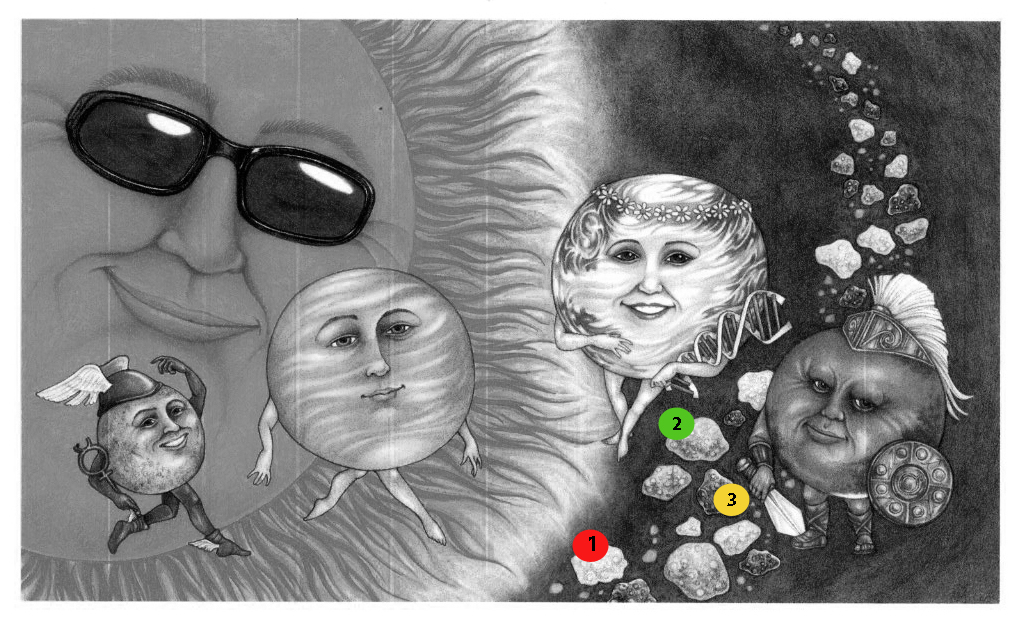
The Asteroid Belt - 3 types of Asteroids
I had to color the asteroids anyway, so I decided to color them accurately.
- M-TYPE: Silvery grey, made up of nickel and iron
- S-TYPE: Reddish brown, made up of rocky material
- C-TYPE: Black, made up of carbon
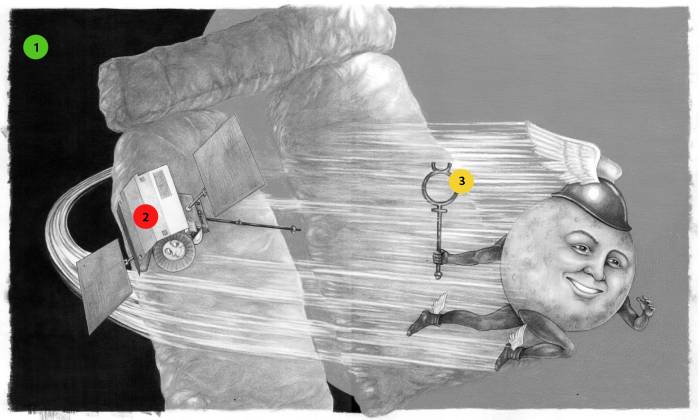
Mercury
Mercury is closest to the Sun, which looks three times bigger than it does on Earth, so that is why the Sun fills up most of the page. The monolithic stones of Stonehenge also change size throughout the course of the book according to the scale of the different planets.
- ATMOSPHERE of Mercury is too thin to scatter light waves, so the sky always looks black, even in the daytime.
- MESSENGER: the spacecraft is supposed to go into orbit around Mercury in 2011 (the 1st mission since Mariner 10 in 1974-75)
- SYMBOL OF MERCURY
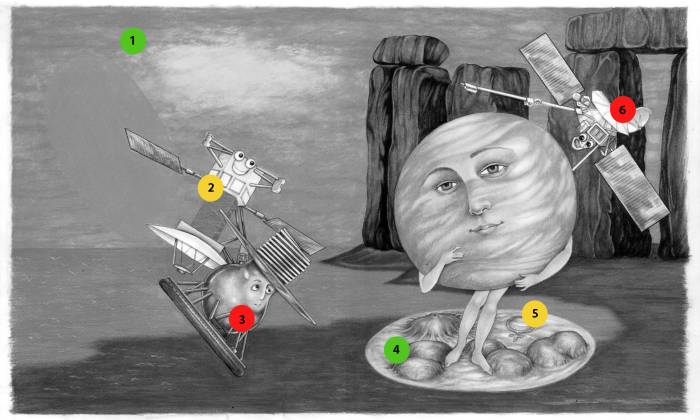
Venus (Goddess of Love)
I knew immediately that the layout, and general look, of the Venus page would be based on the painting, "The Birth of Venus�, by Botticelli. The planet is posed just as the goddess, Venus, in the painting, and has the same face. Three space probes stand in for the nymphs, images of Venus� volcanoes replace the clamshell, Stonehenge serves as the forest edge, and the horizon and shadows are all in keeping with the Botticelli work.
- ATMOSPHERE is so thick it always looks like a cloudy day. The sky is orange. Thick atmosphere causes sunlight to bend so the Sun looks like a flat oval shape in the sky.
- MAGELLAN: 1990 US planetary probe
- VENERA 14: 1982 Russian spacecraft, landed on Venus and sent back photos & data for only 57 minutes before metlting.
- IMAGES OF SOME OF VENUS' VOLCANOES: one group has flattened round domes that look like pancakes, another looks like a giant spider.
- VENUS' SYMBOL
- MARINER: 1962 NASA spacecraft, 1st to visit another planet
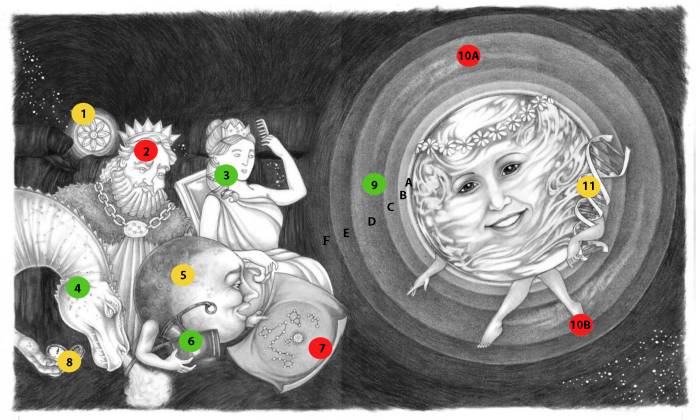
Mother Earth
The narration says she has "given life to everything from daisies to dinosaurs" so that is why she holds a DNA strand bouquet and wears a daisy chain tiara. The constellation Draco was originally going to look more like a dragon but then I decided to follow the story and changed it to a dinosaur (in this case a sub-adult Tyrannosaurus).
- THE POLE STAR (aka the North Star): look inspired by the Babylonian depiction of the "Morning Star."
- CEPHEUS THE KING: one of the Circumpolar Constellations seen in the night sky (Northern Hemisphere) NOTE: The constellation is pictured on his chain
- CASSIOPIA THE QUEEN: another Circumpolar Constellation. She is usually depicted sitting in a chair, holding either a feather, a mirror, or a comb. NOTE: Her constellation is pictured on her crown
- DRACO THE DRAGON: another Circumpolar Constellation (I purposely made him look like a dinosaur since that was mentioned in the copy and dinosaur fossils probably gave rise to the idea of "dragons"). His constellation is hidden in the pattern on his neck.
- MOON: a Gibbous Moon (falls between 1st Quarter and Full).
- BIG & LITTLE DIPPERS: more Circumpolar Constellations NOTE: The Moon holds the dippers to illustrate the "trick" of finding the North Star: Look for the Big Dipper and follow the lip to the end of the handle of the Littler Dipper)
- CIRCUMPOLAR MAP
- COMPASS (pointing North) & EARTH'S SYMBOL
- LAYERS OF EARTH'S ATMOSPHERE: A. Troposhere B. Stratosphere C. Mesosphere D. Ionoshpere E. Thermosphere F. Exosphere/ Space
- (a & b) AURORAS at Earth's poles
- DOUBLE HELIX: building blocks of Life
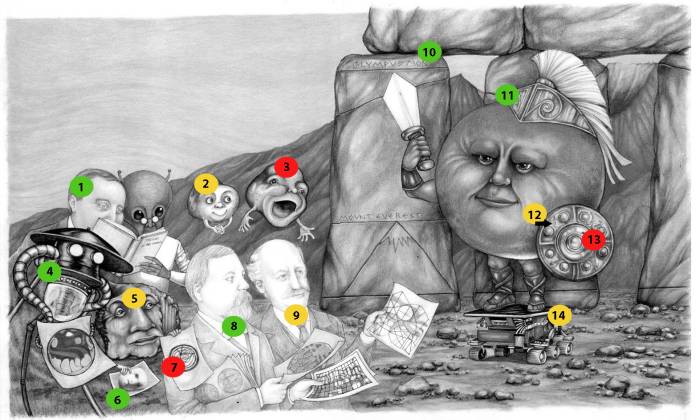
Mars (God of War)
The color and look of the ground and sky is based on actual photos taken on the surface of Mars.
- H. G. WELLS: (1866 - 1946) English writer, reading a 1st edition copy (1897) of his novel, "War of the Worlds", with a Martian
- DEIMOS: moon of Mars
- PHOBOS: moon of Mars (has a big round crater, that's why his mouth is like that)
- WAR OF THE WORLDS MARTIAN: variation, as described in H. G. Wells' book
- ALH840001.0: knocked off Mars by an asteroid impact and landed on Earth 13,000 years ago and discovered in Antarctica in 1984.
- PHOTO OF "THE FACE": taken by Viking 1 in 1976. Thought, by some, to be a stone monument it just turned out to be a natural rock formation that cast unusual shadows.
- MAP OF MARTIAN SOUTHERN POLE: an inside joke since ALH84001.0 was found at Earth's South Pole.
- GIOVANNI SCHIAPARELLI: (1835 - 1910) Italian astronomer. Made a close study of Mars' surface, noticed a series of dark lines that looked to form some sort of "network." He called them "canali" (canals).
- PERCIVAL LOWELL: (1855 - 1916) American astronomer. Made a beautiful series of drawings of the Martian canals described by Schiparelli (NOTE: Several characters are holding Lowell and Schiaparelli's drawings).
- OLYMPUS MONS: largest volcano in the solar system (shown on Stonehenge in relation to Earth's Mount Everest)
- ARIES THE RAM: in Astrology, Mars is considered the Ruling Planet of Aries (symbolized by the ram horns on the helmet)
- SYMBOL FOR IRON: the iron-rich soil of Mars
- SYMBOL FOR MARS: a shield and sword
- SOJOURNER: (1977) rover that collected samples from Martian surface.
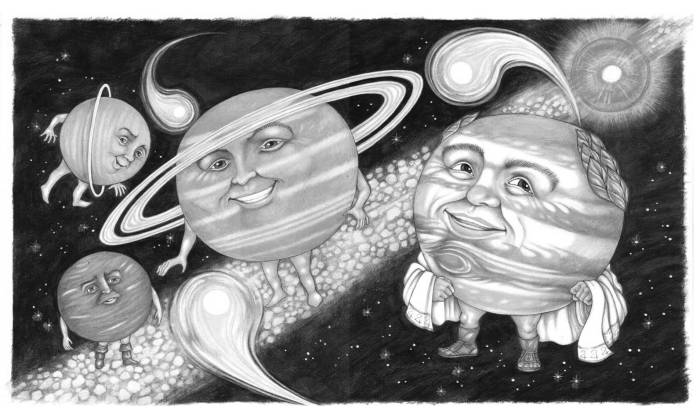
The Outer Planets
The narration explains that the outer planets all have rings, however in the case of Jupiter and Neptune they are very hard to see and do not always show up in photographs. This is why, when I did this illustration originally, I forgot to draw their rings and had to go back and add them. A clear case of NOT paying enough attention to the material! NOTE: The art used here and on Jupiter, Neptune and the Conclusion are the original illustrations, sans rings
Back to Top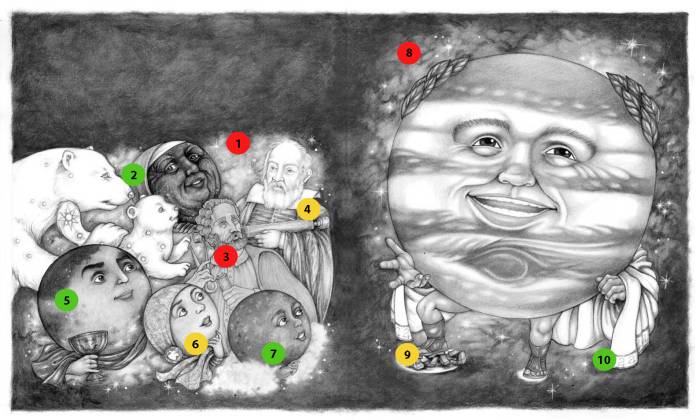
Jupiter (King of the Gods)
I actually messed up the background on this illustration, whited it out and painted over it. Originally the Small and Large Magellanic clouds were both going to be behind Jupiter but I realized I could hide my mistake if i moved the Small cloud to the other page. I should note, this was not the only illustration I�ve ever messed up, in this book or any of the others, (fortunately I�ve just managed to find a way to fix it).
- SMALL MAGELLANIC CLOUD: the smaller of 2 irregular dwarf galaxies visible in the Southern Hemisphere, named for Magellan, the 1st European to see them. NOTE: Though he was not the 1st human being to see or record them.
- CALLISTO: one of the 4 largest of Jupiter's moons. Discovered by Galileo so they are called the "Galilean Moons." In mythology, Jupiter/Zeus placed Callisto and her son in the heavens as Ursa Major & Ursa Minor (the Big and Little Bears). NOTE: The Big Bear is a polar bear as a nod to my 4th book, "Fur and Feathers".
- MAGELLAN: (1480 - 1521) Portuguese navigator who commanded the first expedition to voyage around the world (although he did not complete the trip). One of the 1st Europeans to see the Magellanic Clouds.
- GALILEO: (1564 - 1624) Italian astronomer who revolutionized astronomy and proved Copernicus' theory that the Earth revolves around the Sun (among a whole slew of other discoveries). Discovered the 4 largest moons of Jupiter.
- GANYMEDE: largest Galileon moon. In mythology, Jupiter/Zeus carried Ganymede up to Mount Olympus, in the form of a giant eagle, to serve his cup bearer (that is why the moon is holding a cup with an eagle on it).
- EUROPA: smallest Galileon Moon with relatively smooth icy surface with network of grooves (shown on her scarf) where the ice crust has cracked. In mythology, Europa was a Phonecian noblewoman who met Jupiter/Zeus when he disguised himself as a white bull (seen on her earring).
- IO: Sulfur covered moon with many erupting volcanoes. In mythology, Io was a nymph who met Jupiter/Zeus when he disguised himself as a cloud. Her smokey stole represents both her volcanic surface and Jupiter's disguise.
- LARGE MAGELLANIC CLOUD: largest of the irregular dwarf galaxies visible in the Southern Hemisphere. Discovered by Al-Sufi (pictured on the 1st page) and mentioned in his "Book of Fixed Stars."
- HEAVIEST PLANET: Jupiter crushes Stonehenge
- JUPITER'S SYMBOL
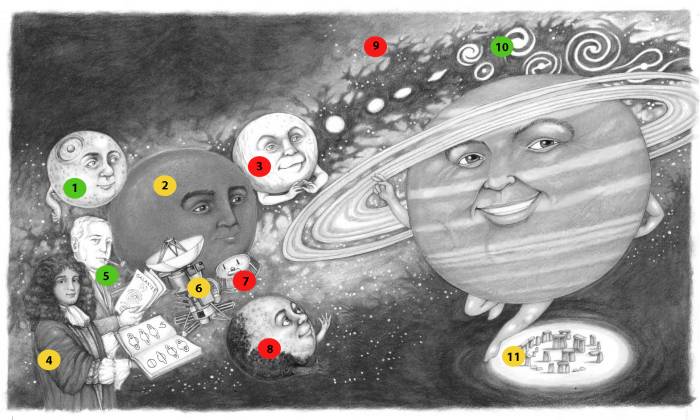
Saturn (God of Agriculture)
The Milky Way background pattern was not in my original rouh sketch. I added it during the color process when I realized a plain, solid-colored sky/space looked kind of dull, particularly compared to all the other illustrations (plus I had this beautiful image of the Milky Way I wanted to find a use for).
- MIMSA: one of Saturn's moons. The enormous crater is named, Herschel.
- TITAN: the largest of Saturn's moons, covered by thick nitrogen and hydrogen-rich atmosphere that hides the surface.
- ENCELADUS: an icy moon with parallel fissures nicknamed "tiger stripes."
- CHRISTIAAN HUYGENS: (1629 - 1695) Dutch scientist & astronomer who, among many discoveries, identified and described Saturn's rings. NOTE: Saturn's symbol is at the top of the page in Huygen's books
- EDWIN HUBBLE: (1889 - 1953) American astronomer. 1st to study distant star systems, he devised a classification of galaxies according to shape. The Hubble Telescope is named after him.
- CASSINI SPACE PROBE: (2004) US spacecraft reaches Saturn
- HUYGENS PROBE: (2004) dropped from Cassini spacecraft to land on Titan and transmit data.
- IAPETUS: two-toned moon
- THE MILKY WAY: NOTE: was added to the illustration during the color process because I thought a plain, solid colored background looked boring.
- HUBBLE GALAXIES: the different shaped galaxies Hubble discovered/described.
- LIGHTEST PLANET: Saturn floats above Stonehenge.
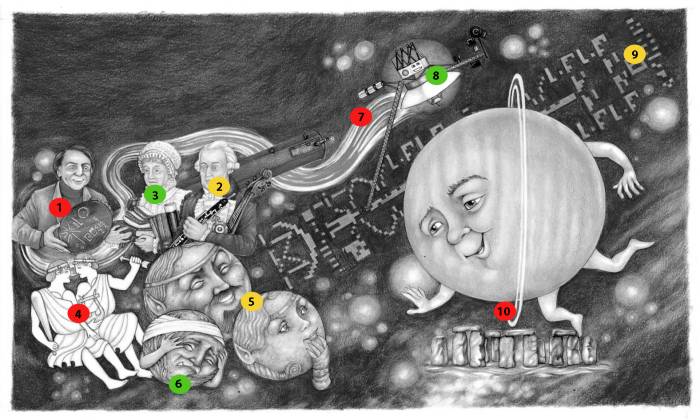
Uranus (God of the Heavens)
Another background technique that wasn't planned and came about on an impulse. I wanted different stars than I'd already used on previous pages and read about a technique I had not tried before of pressing a little ball of mounting putty against the page after the color was applied and peeling it off. This made a nice glow effect and I went back and added little touches of color for interest.
- CARL SAGAN: (1934 - 1996) American astronomer & astrophysicist. Among many achievements Sagan helped develop and assemble the gold record, containing sounds and images of Earth, that was sent on the Voyager space probes.
- WILLIAM HERSCHEL: (1738 - 1822) English musician & astronomer who discovered Uranus. He played the oboe, cello, and harpsichord which is why he is holding the music and instruments in his arms (he also holds Uranus' symbol). His telescope is behind him.
- CAROLINE HERSCHEL: (1750 - 1848) English astronomer, sister of William Herschel. She was the 1st woman to find a new comet and eventually discovered 8. She served as assistant and housekeeper for her brother, feeding him soup and sandwiches while he ground lenses, a time consuming process that could take up to 16 hours or more and once started could not be stopped until completed (which explains the plate of sandwiches she holds).
- CONSTELLATION GEMINI: where Herschel found Uranus
- OBERON & TITANIA: two largest moons, discovered by Herschel, named for the fairy King and Queen in Shakespeare's "A Midsummer Night's Dream."
- MIRANDA: another moon (also named after a Shakespearan character). Seemingly composed of a jumble of huge rocks scientists suggest a huge impact blew Miranda apart and the pieces drifted back together through gravitational attraction.
- RED SHIFT: When an object travels away from the observer, the light waves are lengthened and the object appears to move into the red end of the electromagnetic spectrum.
- VOYAGER 2: (1979) one of two unmanned American space probes sent to explore the outer planets. Voyager 2 passed Uranus, and sent back data, in January 1986.
- DIGITAL MESSAGE: a set of 1,670 on-off pulses was transmitted into space sending a message to any intelligent life form that might be out there somewhere. This number is the result of multiplying to prime numbers, 23 and 73, and the message becomes clear when laid out in 73 rows of 23 columns. With black squares for 1s and white squares for 0s, a pattern of pictogram is produced.
- TILTED PLANET: Uranus is tilted on its side as it orbits around the Sun, the result of a catastrophic collision (that's why I show Uranus tripping over Stonehenge.)
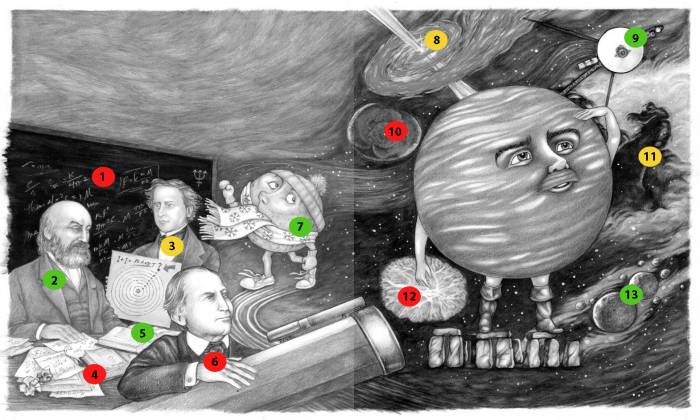
Neptune (God of the Sea)
The addition of the Kuiper Belt was a last minute replacement when I realized the nebula I was planning to use was another "Dark Nebula". I already had a dark one represented with the Horsehead Nebula and I didn't want to be redundant so I went on a mad scramble through all my books trying to find something different to put in that corner. From an art standpoint the choice also helped tie in all the random colors I was using on this page.
- NEWTON'S LAW OF UNIVERSAL GRAVITATION: or at least a small portion of it. Part of the mathematical formula by which Neptune was discovered. NOTE: Neptune's symbol is in the top right corner of the blackboard.
- JOHN COUCH ADAMS: (1819 - 1892) a British mathematician who discovered Neptune mathematically.
- URBAIN LEVERRIER: (1811 - 1877) a French mathematician who also discovered Neptune mathematically.
- GALILEO'S BOOK: a nod to Galileo who saw Neptune in 1612, but thought it was a star.
- NAUTICAL ALMANAC: first published in 1766, it provided a series of tables showing the distances between certain key stars and the Moon at three-hour intervals (just one of many tools used to help in the search for answers, proofs, and discoveries).
- JOHANN GALLE: (1812 - 1910) A German astronomer who used Leverrier and Adams' mathematical predictions and is the 1st person credited to see Neptune.
- TRITON: moon. Coldest object in the solar system NOTE: the snowflake logo is part of the Extreme Cold Warning symbol). Triton is tilted relative to Neptune's equator and moves in the opposite direction in which Neptune rotates.
- QUASAR: a distant star-like object with an enormous energy output that is brighter than an ordinary galaxy (possibly fueled by a super massive Black Hole).
- VOYAGER 2: 1989 - after traveling through space for 12 years Voyager 2 passed Neptune
- CAT'S EYE NEBULA: a "Planetary Nebula," named due to its shape. It is/was a sun-like star that died and shed its outer layer of hydrogen gas.
- HORSE HEAD NEBULA: a dense cloud of gas and dust called a "Dark Nebula" because it blocks light from the Emission Nebula behind it.
- CRAB NEBULA: remnant of a supernova that Chinese astronomers first observed in 1054.
- KUIPER BELT: region of the solar system beyond Neptune believed to contain millions of small primitive bodies in orbit around the Sun. Pluto is found in this region.
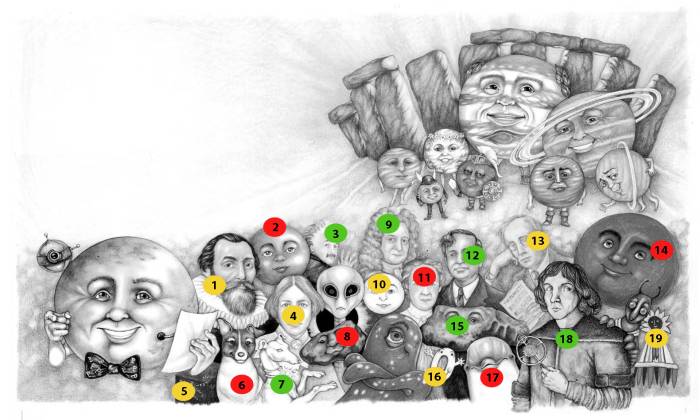
Conclusion
Many of the same historical and scientific figures kept coming up in my research so that is why they were chosen for the audience. Some names were and are simply so iconic they had to be included n a book about the solar system. Other choices were made for personal or esthetic reasons. And some were pure whimsey.
My hope is that readers will be intrigued to find more information about the characters and elements that were represented, and that they will challenge me with the suggestions of other names that should have been included.
- JOHANNES KEPLER: (1751 - 1630) A German mathematician who formulated three laws of planetary motion. The 1st states that all planets orbit the Sun in elliptical paths.
- BLUE STAR: tens of times bigger than the Sun and tens of thousands of times brighter.
- ALBERT EINSTEIN: (1879 - 1955) a German physicist whose theories transformed the way we look at time and space.
- MARIA MITCHELL: (1818 - 1889) An American astronomer, the 1st woman since Caroline Herschel to discover a comet, 1st woman member of the American Academy of Arts and Sciences, and the 1st person (male or female) appointed to the faculty of Vassar College, where she became professor of astronomy and director of the Vassar College Observatory.
- "STICKMAN": a nickname given to the image seen on the map of 1,000 nearby galaxies by astronomer Margaret Geller, who along with her colleagues, made the map in 1986.
- LAIKA: 1957, Soviet Union dog that was 1st living creature from our world sent into space aboard Sputnik 2.
- SIRIUS/CANIS MAJOR aka the Dog Star: The brightest star in the night sky, called the Dog Star because it anchors the constellation Canis Major (Big Dog). NOTE: On ancient star maps the dog is usually depicted as a greyhound or a mastiff.
- ASTEROID GASPARA: (11 miles across) one of the 1st asteroids photographed by the Galileo spacecraft.
- EDMOND HALLEY: (1656 - 1742) An English astronomer who was the 1st to discover that some comets are regular visitors.
- WHITE DWARF: a tiny hot star only about the size of Earth.
- HENRIETTA LEAVITT: (1868 - 1921) An American astronomer whose discovery of the period luminosity relation of "Cepheid Varables" (a class of pulsating variable stars that helps determine the distance between many stars and galaxies) changed the theory of modern astronomy. NOTE: She received almost no recognition for this in her life time.
- SUBRAHMANYAN CHANDRASEKHAR: (1910 - 1995) An Indian astrophysicist (later became an American citizen) who was awarded the Nobel Prize in Physics in 1983 for his studies on the physical processes important to the structure and evolution of stars. His most notable work was the "Astrophysical Chandrasekhar Limit" which described the maximum (or minimum) mass a White Dwarf Star will ultimately collapse into a Neutron Star or Black Hole � following a supernova.
- GUSTAV HOLST: (1874 - 1934) An English composer known for his orchestral suite. "The Planets."
- RED GIANT: luminous stars, but cool because of their size, usually 30 times the size of the Sun.
- ASTEROID IDA: (35 miles across) another asteroid photographed by the Galileo spacecraft.
- ZERO: its use/discovery is attributed to India where calculations were being carried out by the 9th century, it was also an integral part of the Mayan number system.
- DOLPHIN DISC: in the Hindu collection of stories called "Bhagavata Purana," all the visible stars and planets moving through space are likened to a dolphin swimming through the water. The heavens are called the Dolphin Disc.
- NICOLAUS COPERNICUS: (1473 - 1543) A Polish astronomer who suggested that the Sun was at the center of the planetary system, not the Earth.
- HALLEY'S COMET: as portrayed in the Bayeux Tapestry (11th or 12th century). One of many artistic depictions of the comet that have come from a variety of different cultures and time periods.